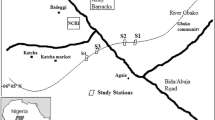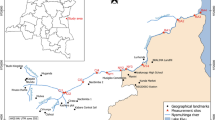Abstract
This study investigated the effect of the main physicochemical factors in structuring aquatic macroinvertebrate assemblages of three streams in northern Tunisia. Aquatic macroinvertebrate and water physicochemical surveys were carried out seasonally in 2013, at three pristine sites and three altered sites located, respectively, in the upstream and downstream parts of the streams investigated. Macroinvertebrates were sampled using a kick net and a Surber net, and eight physicochemical factors were measured at the same time. Both biotic and abiotic data were analyzed using STATICO method. A total of 41 macroinvertebrate taxa were collected during the sampling period, and the most dominant taxa were Diptera (Culicidae) and Oligochaeta (Tubificidae). STATICO identified the dissolved oxygen, COD, and BOD5 as the major abiotic factors shaping macroinvertebrate assemblages. This study highlighted the impacts of anthropogenic land-based activities such as urban runoff on the distribution and diversity of macrobenthic invertebrates at the three downstream sites.
Access provided by Autonomous University of Puebla. Download conference paper PDF
Similar content being viewed by others
Keywords
1 Introduction
Freshwater macroinvertebrate communities constitute a key element for both food web structure and ecosystem health. However, freshwaters are often heavily impacted by anthropogenic activities altering water quality and macroinvertebrate diversity [1]. Water quality represents a big challenge for the future, considering global change and human activity increase, particularly in dry countries such as those located in the Southern Mediterranean Basin.
The goals of this study were: (1) to assess the spatial and seasonal variation of macroinvertebrate assemblages of three streams located in northern Tunisia, and (2) to examine which abiotic factors determine the spatial and temporal structure of these macroinvertebrate assemblages.
2 Materials and Methods
Three pristine sites (P), located in the upstream part of each stream, and three sites altered by anthropogenic activities (A), located in the downstream reach, were selected for this study and sampled seasonally in 2013: Kasseb (ST1-P, ST2-A), El Bey (ST3-P, ST4-A), and Lebna (ST5-P, ST6-A). Salinity (S), dissolved oxygen (DO), and pH were measured with standard portable equipment (WTW, MPP350). The [NO3−], [NH4+], [PO42−], [COD], and [BOD5] were determined in the laboratory. Macroinvertebrates were collected using kick net and Surber sampler, stored in 70% ethanol and transported to the laboratory for the identification of taxa which was made using a binocular stereomicroscope and available keys [2]. The STATICO method [3], was carried out to analyze the two series of data in a spatial–temporal framework, where the spatial or the temporal sampling repetition provides a third dimension to the dataset. Analyses were performed using the ade4 package [4], of R software [5].
3 Results
3.1 Macroinvertebrates and Environmental Parameters
A total of 41 taxa of macroinvertebrates were collected in the 24 samples from 6 sampling sites. While richness tended to be higher in the pristine site, abundance was higher in the altered ones. The taxonomic group with highest taxa richness in pristine sites was Coleoptera (with 10 taxa) followed by Heteroptera (7 taxa). Compared with Coleoptera and Heteroptera, Odonata (3), Ephemeroptera (3), Crustacea (4), and Mollusca (3) were relatively poor. However, in the three altered sites, Annelida were represented by eight taxa, and Diptera by three species. The dominant macroinvertebrate taxa were also different. Thus, the dominant taxa at pristine sites were Ostracoda (15.61%), and Anopheles sp (36.81%) at altered sites. Environmental factors showed spatial differences between sampling sites and temporal differences among seasons (Table 1). The pH values varied from 5.09 to 8.05 (mean = 7.25 ± 0.86). All sites had mean salinity between 0.55 PSU and 1.88 PSU, the lowest in winter (0.46 PSU at site 2) and the highest in summer (2.1 PSU at site 6). Lower mean DO and higher mean [NO3−], [NH4+], [PO42−], [COD], and [BOD5] were found at the three altered sites than at the three pristine sites.
3.2 Community Analysis and Relationship with Environmental Parameters
3.2.1 Interstructure
The factor map of the interstructure, with the first principal component explaining 60.3% of the total inertia and the second 16.3%, identified two main groups of seasons (Fig. 1a). This suggested that only the first axis might be chosen for the compromise analysis. The correlation circle showed all the sampling dates displaying the same sign on the first interstructure factor (axis 1), indicating a positive correlation between the corresponding set of matrices (Fig. 1a).
To build the compromise, the weights of each pair of tables ranged from 0.438 to 0.571 (Fig. 1d). The Spring–Summer seasons were different from the Autumn–Winter seasons. This means that the co-structures between environmental parameters and macroinvertebrate communities were different in Spring–Summer and Autumn–Winter.
3.2.2 Compromise
Out of the eight environmental factors taken into account, only a few were found to be correlated with the structure of macroinvertebrate assemblages (Fig. 1b). The first axis described a positive association with COD, BOD5, [PO42−], and [NH4+], and a negative association with pH and DO. The second axis was mainly positively associated with the salinity but negatively associated with [NO3−]. The correspondence with the macroinvertebrate taxa allowed identifying those taxa more clearly related to the environmental gradients (Fig. 1c). On the first axis, the most abundant taxa (Oligochaeta Tubificidae and Diptera Culicidae) were associated with sites having higher BOD5 and COD, and were opposed to the other taxa, as Ostacodes, associated with sites characterized by higher DO.
4 Discussion
Water chemistry is an important factor in shaping macroinvertebrate assemblages [6]. The spatial patterns of macroinvertebrate assemblages at the six sites were highly persistent along the four seasons. Both the abundance and richness of Diptera and Oligochaeta were positively related to pollution parameters COD and BOD5. The environmental factors which most influenced the macroinvertebrate assemblages also changed with seasons. Furthermore, a specific differentiation is related to upstream sites (unpolluted situation: high oxygen concentration and high pH) occupied mainly by some insect groups (e.g., beetles, bugs, mayflies), and downstream sites (highly polluted situation: high concentrations of ammonium and phosphates, high rate of chemical oxygen demand, and biological oxygen demand), where highly pollutant resistant species as Oligochaeta and the Diptera Anopheles sp. proliferated.
5 Conclusions
Macroinvertebrate assemblages varied both spatially and temporally in response to the abiotic and biotic factors. According to the spatial distribution, macroinvertebrates could be classified into two groups based on their sensitivity to pollution, being Diptera, and noninsect taxa such as Annelids (Oligochaetes) which are mostly associated with pollution parameters (COD and BOD5).
References
Boothby, J.: Tackling degradation of seminatural landscape: options and evaluations. Land Degrad. Dev. 14, 227–243 (2003)
Tachet, H.: Invertébrés d’eaux douces (Systématique, Biologie, Ecologie)—CNRS (2000)
Thioulouse, J., Simier, M., Chessel, D.: Simultaneous analysis of a sequence of paired ecological tables. Ecology 85, 272–283 (2004)
Thioulouse, J., Dray, S., Dufour, A.B., Siberchicot, A., Jombart, T., Pavoine, S.: Multivariate Analysis of Ecological Data with ade4, 330 pp. Springer, New York (2018)
R Development Core Team: R: a language and environment for statistical computing. R: Vienna (2010). https://www.r-project.org/. Accessed 18 Dec 13
Shieh, S.H., Chi, Y.S.: Factors influencing macroinvertebrate assemblages in artificial subtropical ponds of Taiwan. Hydrobiologia 649, 317–330 (2010)
Author information
Authors and Affiliations
Corresponding author
Editor information
Editors and Affiliations
Rights and permissions
Copyright information
© 2021 The Editor(s) (if applicable) and The Author(s), under exclusive license to Springer Nature Switzerland AG
About this paper
Cite this paper
Slimani, N., Sánchez-Fernández, D., Guilbert, E., Boumaïza, M., Thioulouse, J. (2021). Water Quality Shapes Freshwater Macroinvertebrate Communities in Northern Tunisia. In: Ksibi, M., et al. Recent Advances in Environmental Science from the Euro-Mediterranean and Surrounding Regions (2nd Edition). EMCEI 2019. Environmental Science and Engineering(). Springer, Cham. https://doi.org/10.1007/978-3-030-51210-1_301
Download citation
DOI: https://doi.org/10.1007/978-3-030-51210-1_301
Published:
Publisher Name: Springer, Cham
Print ISBN: 978-3-030-51209-5
Online ISBN: 978-3-030-51210-1
eBook Packages: Earth and Environmental ScienceEarth and Environmental Science (R0)





